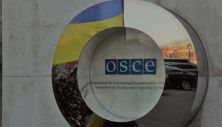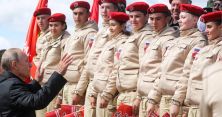Iran’s newly-minted strategic partnership treaty with Russia may not be more than a bargaining chip if the first five years of Iran’s 25-year,...
Vous n'êtes pas connecté
- English
- Français
- عربي
- Español
- Deutsch
- Português
- русский язык
- Català
- Italiano
- Nederlands, Vlaams
- Norsk
- فارسی
- বাংলা
- اردو
- Azərbaycan dili
- Bahasa Indonesia
- Հայերեն
- Ελληνικά
- Bosanski jezik
- українська мова
- Íslenska
- Türkmen, Түркмен
- Türkçe
- Shqip
- Eesti keel
- magyar
- Қазақ тілі
- Kalaallisut ; kalaallit oqaasii
- Lietuvių kalba
- Latviešu valoda
- македонски јазик
- Монгол
- Bahasa Melayu ; بهاس ملايو
- ဗမာစာ
- Slovenščina
- тоҷикӣ ; toğikī ; تاجیکی
- ไทย
- O'zbek ; Ўзбек ; أۇزبېك
- Tiếng Việt
- ភាសាខ្មែរ
- རྫོང་ཁ
- Soomaaliga ; af Soomaali
Rubriques :
 Maroc - EURASIAREVIEW.COM - A la une - Hier 00:51
Maroc - EURASIAREVIEW.COM - A la une - Hier 00:51
Russia, Iran, And The Anti-Western Axis Of Upheaval – OpEd
The Anti-Western Axis of Upheaval uniting Russia, Iran, North Korea and China is complete. Iran and Russia signed a Comprehensive Strategic Partnership Agreement (CSPA) this month in Moscow. The CSPA followed the Comprehensive Strategic Partnership signed by Russia and North Korea in June of last year, establishing a military alliance and the sending of 12,000 troops to fight the Kremlin’s war against Ukraine, and a Russian-Chinese partnership agreement signed in March 2021. The Kremlin’s plans for the Anti-Western Axis of Upheaval are to challenge and destroy the US-led world order. Each of its members are either at war or a threat to their neighbourhoods. Iran, leading what it calls the Axis of Resistance, has long led the fight against Israel and Western interests in the Greater Middle East. Russia launched a full-scale invasion and is at war with Ukraine. North Korea is a potential threat to democratic South Korea. Chinese leaders plan to take control over Taiwan by the end of this decade. Iran is a threat to Israel, Azerbaijan and Ukraine. Iran is weakened but not removed as a threat. After the fall of the Assad dictatorship Iran lost its Syrian base. Its Lebanese Hezbollah and Gaza Hamas proxies are degraded. Russia and Iran have not always been allies. In the nineteenth century Iran and Russia fought over the South Caucasus. After the Qajar Dynasty lost lost territory to the Russian Empire, Persia views the period as a ‘century of humiliation.’ China views the nineteenth century in a similar way after losing eastern Siberia to the Russian Empire. The Soviet Union invaded Iran in World War II and threatened to incorporate Southern Azerbaijan into the Soviet Azerbaijani Republic. Only after US pressure was Soviet dictator Joseph Stalin forced to withdraw. The Soviet Union backed Iraq in its long war with Iran from 1980-1988. Finally, Russian President Dmitri Medvedev supported UN sanctions against Iran over its nuclear ambitions. Since then, times have changed. Since 1991, the Iranian theocratic regime has targeted Azerbaijan, long before it became Russia’s ally in the Kremlin’s war against Ukraine and Iran was an ally of Armenia throughout the nearly three decades it occupied a fifth of Azerbaijan. Despite Persia and Russia having a history of territorial conflict, their nationalisms are remarkably similar. Their nationalistic images of where their Iranian and Russian empires extend are far greater than the lands inhabited by Persians and Russians. The Kremlin views Eurasia, including the South Caucasus, as its exclusive sphere of influence and Ukraine as a renegade province that needs to be forcefully returned to Mother Russia. Persian nationalists view Azerbaijan as a renegade Iranian province that should be returned to Iran. Russians and Iranians use religion to lay claims towards Ukraine and Azerbaijan. Russian nationalists see Ukrainians as fellow Orthodox brethren and Ukraine as part of ‘Holy Rus.’ Persian nationalists look to the common Shiite religion of Iran and Azerbaijan. Ultimately, heavy handed Russian and Persian nationalists pushed Ukrainians and Azerbaijani’s away from them. Russia launched two military invasions in 2014 and 2022 and occupied Crimea. Iran supported Russian and Persian nationalists refuse to allow Ukrainians and Azerbaijanis to have agency to decide their ow domestic and foreign policies. Ukraine seeks to turn its back on centuries of Russian and Soviet colonial rule and join NATO and the European Union. Azerbaijan is turning away from centuries of Russian, Soviet and Persian colonial rule and be a non-aligned country with strategic relations with Türkiye and Israel. Russia and Iran cannot accept that the ‘renegade provinces’ of Ukraine and Azerbaijan become rising powers. Ukraine has numerous rare raw materials, energy resources and rich agriculture and has built one of the best defence sectors in the world. Based on its Soviet era military industrial complex and new technologies developed during Russia’s war against Ukraine. After liberating most of its occupied lands in 2020, Azerbaijan is becoming the predominant country in the South Caucasus. Europe’s disavowal of Russian energy supplies has boosted demand for Azerbaijani (and Norwegian, US, and other countries) energy supplies. Azerbaijan energy is supplied to Europe through Türkiye. With the loss of its biggest energy market in Europe, Russia is seeking to build a South energy corridor to Iran and India. Although Russia and Iran cooperate on energy they compete for exports to China which account for 90 percent of Iranian exports. Russia, Iran, and other members of the Anti-Western Axis of Upheaval are contemptuous of international law and duplicitous on the question of the territorial integrity of states. China is a staunch supporter of its own territorial integrity but also is the main external supporter of Russia’s militarily machine. Iran claims it does not support Russia’s annexation of Ukrainian lands. At the same time, Iran is a close ally of Armenia that occupied a fifth of Azerbaijan between the two Karabakh Wars (1994-2020). Iran provided diplomatic, economic and energy support to the Armenian nationalists who ruled Karabakh until September 2023 when Azerbaijan regained control over the last part of its occupied territory. Armenian and Iranian interests match in practically every area, Tehran ATU University Professor Ehsan Movahedian said. They both complain about the rise of Türkiye’s influence in Azerbaijan, Syria, Libya and elsewhere in the Greater Middle East. The Iranian-Armenian Friendship Group visited Armenia this month and met in the Armenian parliament. While Armenia is a democracy this is most certainly not the case with Iran which the US human rights think tank Freedom House defines as Not Free. The head of the Iran-Armenia Friendship Group Ara Shahverdyan stated Iran’s support for the territorial integrity of Armenia and ‘opposed geopolitical changes in borders and the region,’ a euphemism referring to Azerbaijan’s military partnership with Israel and Türkiye. The Anti-Western Axis of Upheaval emboldens Iran to be more aggressive towards its neighbours. In 2019, Iran launched missiles and drones against Saudi Arabian oil facilities. Through its proxies, Iran has armed Houthi’s to attack Saudi Arabia. The Iranian delegation described the special place Armenia hols in Iranian foreign policy based on centuries of history and the commonality of both countries threat perceptions and strategic interests. Iran has trained and infiltrated Islamic terrorists into Azerbaijan in a failed attempt to spread Shiite extremism through the Hosseinytes movement which is funded, trained and equipped by Iran’s Islamic Revolutionary Corps Guards. Azerbaijan’s Embassy in Tehran was attacked in January 2023, killing the head of the embassy’s security service. Iran holds annual large military exercises on its Aras River border with Azerbaijan which includes amphibious exercises. As Russia sends over NATO member states, Iran also routinely sends military aircraft to fly over and intimidate Azerbaijan. Iran is lobbying Armenia to block the creation of the Zangezur Corridor linking Azerbaijan and the Azerbaijani enclave of Nakhchivan by crossing Armenia’s province of Syunik only forty kilometres from the sensitive Armenian border with Iran. Iran not coincidentally opened a consulate in Kapan in the province of Syunik. The Zangezur Corridor would enable Azerbaijan to establish a road and rail connection to Türkiye. The biggest manner Iran could become a threat to its neighbours and the Greater Middle East would be if Russia assists it to become a nuclear state. Iran and Russia have a long history of cooperation in the field of civilian nuclear power and was traditionally opposed to Iran building nuclear weapons. Russia is completing the second and third units on the Bushehr nuclear plant. The question now is if Russia has agreed to cross the red line and provide Iran with the necessary specialist knowledge to become a nuclear state, even if they are only of the smaller type akin to tactical nuclear weapons. Suspicion has arisen because of numerous visits to Moscow by Ali Larijani a senior adviser to Iranian Supreme Leader Ayatollah Ali Khamenei. If the US and Israel received intelligence Iran was close to, or had built, nuclear weapons the Greater Middle East would descend into turmoil. US President Donald Trump could give Israel the green light to launch attacks on Iranian nuclear facilities although, because these are built deep underground, it is unclear how successful these would be. The Iranian-Russian military partnership is built upon their common goal of overthrowing the US-led World order by destroying Ukraine and Israel. The Kremlin’s war with Ukraine has shown it never had the second-best army in the world. As a declining great power, Russia has been forced to go with begging bowls for military equipment and troops to smaller countries like Iran and North Korea. As long as their military partnership continues there will always be suspicion Iran will seek expertise from Russia to build nuclear weapons. Both countries are outsiders and see the world in the same conspiratorial, dystopian and anti-American manner. Russia fires a huge number of drones and missiles each day at Ukraine and needs to replenish these from its own stocks, which cannot be quickly rebuilt due to Western sanctions, and drones and short-and-close-range ballistic missiles and glide bombs from Iran and North Korea. Iran in turn, seeks from Russia air defence systems, SU-35 jets and MI-28 helicopters, and Yak-130 combat trainer aircraft, and nuclear weapons technology. Iran is the third largest importer of Russian weapons after India and China. Trump’s determination to end the war in Ukraine will take longer to resolve than his promised ‘24 hours.’ To bring Russia to the negotiating table will not be easy and will only happen if in addition to supplying more lethal military equipment to Ukraine, Trump applies pressure over energy. Russia’s balancing act between Israel and Iran was only possible until the October 2023 Hamas terrorist attack. Russia’s wholehearted tilt since then to Iran, and loss of Syria as a client state, may encourage Saudi Arabia and the UAE to back Trump’s call to reduce the price of a barrel of oil to $40-45 which would be devastating for the Russian economy. By sending Russian weapons captured from Hezbollah and Hamas and missiles for the Patriot air defence system to Ukraine, Israel is no longer neutral towards the Russian-Ukrainian war. The signing of the Iranian-Russian CSPA should be a wakeup call to the US and NATO that the Anti-Western Axis of Upheaval is now a fully-fledged alliance that sees itself to be at war with the West. Russia and Iran seek to destroy Ukraine and Israel respectively and adopt aggressive steps towards their central-eastern European and south Caucasian neighbours.
Articles similaires
Russia-Iran Treaty Signifies A ‘Breakthrough’ In Ties – OpEd
Russia and Iran, as two immediate neighbours and great powers with a glorious history, had a difficult, chequered relationship through centuries. It...
Trump Links Further Ukraine Military Assistance In Exchange For Rare Earth Minerals – Analysis
By Can Kasapoğlu 1. Ukraine’s Critical Mineral Resources Could Contribute to Battlefield Success President Donald Trump said he is...
‘The Russians Worked Fast:’ How Ukraine Lost Its Tactical Nuclear Weapons – Analysis
By Dmytro Shurkhalo (RFE/RL) -- When Ukraine declared its independence from the U.S.S.R in August 1991, Kyiv came into possession of the third...
The Driving Factors Behind Ukraine’s Peace Prospects – Analysis
By Xia Ri Since Russia launched a large-scale military operation against Ukraine in February 2022, the Russia-Ukraine war has continued, with the...
Council of Europe calls for just peace and security guarantees for Ukraine
A just peace is essential for the security of the entire continent and can only be achieved through adequate security guarantees for Ukraine. Any...
Ukraine at OSCE calls for sanctions against defense industry enterprises in Belarus
Ukraine is calling on its partners to impose sanctions against Belarusian defense industry enterprises that help Russia fulfill its state defense...
Overthrow Of Syria’s Assad Echoes Across Post-Soviet Space, Worrying Moscow – Analysis
The effects of the overthrow of the Kremlin’s Syrian client Bashar al-Assad on Russian influence in the Middle East and Africa has become a hot...
Putin is recruiting children for war: how Russia is using the “Yunarmiya” to destroy Ukrainian identity
On February 3, Russian President Vladimir Putin signed a decree that strengthens the control of the Russian Ministry of Defense over the DOSAAF...
Rising Tensions Could Push Iran And Trump Toward A New Deal Or Conflict – Analysis
Iran faced many challenges in 2024: Regional Setbacks: Iran's influence in the Middle East suffered major blows. Israel attacked its embassy in...
Les derniers communiqués
-
Adobe Brings Conversational AI to Trillions of PDFs with the New AI Assistant in Reader and Acrobat
Adobe - 21/02/2024
-
Laura Frigenti takes the Helm as Chief Executive Officer of the Global Partnership for Education
Global Partnership for Education - 05/12/2022


